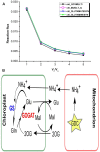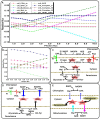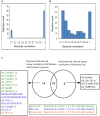Reconstruction of Oryza sativa indica Genome Scale Metabolic Model and Its Responses to Varying RuBisCO Activity, Light Intensity, and Enzymatic Cost Conditions
- PMID: 29250098
- PMCID: PMC5715477
- DOI: 10.3389/fpls.2017.02060
Reconstruction of Oryza sativa indica Genome Scale Metabolic Model and Its Responses to Varying RuBisCO Activity, Light Intensity, and Enzymatic Cost Conditions
Abstract
To combat decrease in rice productivity under different stresses, an understanding of rice metabolism is needed. Though there are different genome scale metabolic models (GSMs) of Oryza sativa japonica, no GSM with gene-protein-reaction association exist for Oryza sativa indica. Here, we report a GSM, OSI1136 of O.s. indica, which includes 3602 genes and 1136 metabolic reactions and transporters distributed across the cytosol, mitochondrion, peroxisome, and chloroplast compartments. Flux balance analysis of the model showed that for varying RuBisCO activity (Vc/Vo) (i) the activity of the chloroplastic malate valve increases to transport reducing equivalents out of the chloroplast under increased photorespiratory conditions and (ii) glyceraldehyde-3-phosphate dehydrogenase and phosphoglycerate kinase can act as source of cytosolic ATP under decreased photorespiration. Under increasing light conditions we observed metabolic flexibility, involving photorespiration, chloroplastic triose phosphate and the dicarboxylate transporters of the chloroplast and mitochondrion for redox and ATP exchanges across the intracellular compartments. Simulations under different enzymatic cost conditions revealed (i) participation of peroxisomal glutathione-ascorbate cycle in photorespiratory H2O2 metabolism (ii) different modes of the chloroplastic triose phosphate transporters and malate valve, and (iii) two possible modes of chloroplastic Glu-Gln transporter which were related with the activity of chloroplastic and cytosolic isoforms of glutamine synthetase. Altogether, our results provide new insights into plant metabolism.
Keywords: light intensity; Oryza sativa indica; enzymatic cost; flux balance analysis; metabolic model; photorespiration.
Figures








Similar articles
-
The knockdown of chloroplastic ascorbate peroxidases reveals its regulatory role in the photosynthesis and protection under photo-oxidative stress in rice.Plant Sci. 2014 Jan;214:74-87. doi: 10.1016/j.plantsci.2013.10.001. Epub 2013 Oct 8. Plant Sci. 2014. PMID: 24268165
-
Revisiting the chlorophyll biosynthesis pathway using genome scale metabolic model of Oryza sativa japonica.Sci Rep. 2015 Oct 7;5:14975. doi: 10.1038/srep14975. Sci Rep. 2015. PMID: 26443104 Free PMC article.
-
A genome-scale metabolic network reconstruction of tomato (Solanum lycopersicum L.) and its application to photorespiratory metabolism.Plant J. 2016 Jan;85(2):289-304. doi: 10.1111/tpj.13075. Epub 2016 Jan 4. Plant J. 2016. PMID: 26576489
-
Emerging concept for the role of photorespiration as an important part of abiotic stress response.Plant Biol (Stuttg). 2013 Jul;15(4):713-22. doi: 10.1111/j.1438-8677.2012.00710.x. Epub 2013 Mar 4. Plant Biol (Stuttg). 2013. PMID: 23452019 Review.
-
Photosynthetic Electron Flows and Networks of Metabolite Trafficking to Sustain Metabolism in Photosynthetic Systems.Plants (Basel). 2024 Oct 28;13(21):3015. doi: 10.3390/plants13213015. Plants (Basel). 2024. PMID: 39519934 Free PMC article. Review.
Cited by
-
GPRuler: Metabolic gene-protein-reaction rules automatic reconstruction.PLoS Comput Biol. 2021 Nov 8;17(11):e1009550. doi: 10.1371/journal.pcbi.1009550. eCollection 2021 Nov. PLoS Comput Biol. 2021. PMID: 34748537 Free PMC article.
-
Transcriptome enhanced rice grain metabolic model identifies histidine level as a marker for grain chalkiness.Sci Rep. 2025 May 12;15(1):16432. doi: 10.1038/s41598-025-00504-6. Sci Rep. 2025. PMID: 40355482 Free PMC article.
-
Elucidating the impact of in vitro cultivation on Nicotiana tabacum metabolism through combined in silico modeling and multiomics analysis.Front Plant Sci. 2023 Nov 3;14:1281348. doi: 10.3389/fpls.2023.1281348. eCollection 2023. Front Plant Sci. 2023. PMID: 38023876 Free PMC article.
-
A diel multi-tissue genome-scale metabolic model of Vitis vinifera.PLoS Comput Biol. 2024 Oct 10;20(10):e1012506. doi: 10.1371/journal.pcbi.1012506. eCollection 2024 Oct. PLoS Comput Biol. 2024. PMID: 39388487 Free PMC article.
-
Metabolic Modeling of the C3-CAM Continuum Revealed the Establishment of a Starch/Sugar-Malate Cycle in CAM Evolution.Front Plant Sci. 2021 Jan 14;11:573197. doi: 10.3389/fpls.2020.573197. eCollection 2020. Front Plant Sci. 2021. PMID: 33584741 Free PMC article.
References
-
- Backhausen J. E., Emmerlich A., Holtgrefe S., Horton P., Müller-Röber B., Scheibe R. (1998). Isolated intact chloroplasts and whole leaves from transgenic potato plants with altered levels of chloroplast NADP-MDH: Interactions between photosynthetic electron transport and malate metabolism. Planta 207 105–114. 10.1007/s004250050461 - DOI
-
- Backhausen J. E., Scheibe R. (1999). Adaptation of tobacco plants to elevated CO2: influence of leaf age on changes in physiology, redox states and NADP-malate dehydrogenase activity. J. Exp. Bot. 50 665–675. 10.1093/jxb/50.334.665 - DOI
LinkOut - more resources
Full Text Sources
Other Literature Sources
Research Materials

